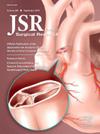青少年甲状旁腺功能亢进:一个更新的当代外科经验在三级中心。
IF 1.8
3区 医学
Q2 SURGERY
引用次数: 0
摘要
原发性甲状旁腺功能亢进症(pHPT)在儿童中并不常见,导致缺乏描述该人群疾病过程的数据。在此,为了弥合信息差距,我们回顾了我们在专业三级转诊中心对20岁以下青少年患者进行pHPT的经验。方法:回顾性分析2004年至2023年间在我院接受手术治疗的所有青少年pHPT患者。收集并分析患者的症状、生化检查、术中发现和结果。结果:纳入49例青少年患者,其中45% (n = 22)为男性。诊断时的中位年龄为16.6岁(14.1-20岁)。入院时,71% (n = 35)有症状,最常见的是肾结石(35%,n = 17)。术前中位钙和甲状旁腺激素分别为12 mg/dL(11.3-12.6)和128pg/mL(105-170.5)。61% (n = 30)的患者行集中甲状旁腺切除术,39% (n = 19)的患者行四腺探查。86%的人患有单一腺瘤,14%的人患有多腺疾病。术前超声定位和Sestamibi定位的敏感性分别为57%和59%。当结合两种成像方式时,灵敏度增加到78%(阳性预测值91%)。无手术并发症。在中位随访61.0个月时,发现4%的患者有复发性pHPT。年龄较小(OR 0.64, P = 0.038)和散发疾病(OR 0.04, P = 0.050)的复发可能性较小。结论:青少年pHPT患者多有症状,多为单腺体病变。青少年pHPT应像成人pHPT一样治疗,使用术中PTH和两种术前成像方式。本文章由计算机程序翻译,如有差异,请以英文原文为准。
Adolescent Hyperparathyroidism: An Updated Contemporary Surgical Experience at a Tertiary Center
Introduction
Primary hyperparathyroidism (pHPT) in children is uncommon, resulting in a paucity of data describing the disease process in this population. Herein, in an effort to bridge the information gap, we review our experience with pHPT in adolescent patients under 20 y of age at a specialized tertiary referral center.
Methods
A retrospective chart review included all adolescent patients with pHPT, who underwent surgery at our institution between 2004 and 2023. Presenting symptoms, biochemical workup, intraoperative findings, and outcomes were collected and analyzed.
Results
Forty-nine adolescent patients were included, with 45% (n = 22) being male. The median age at diagnosis was 16.6 y (14.1-20). On presentation, 71% (n = 35) were symptomatic, most commonly nephrolithiasis (35%, n = 17). The median preoperative calcium and parathyroid hormone were 12 mg/dL (11.3-12.6) and 128pg/mL (105-170.5), respectively. Focused parathyroidectomy was performed in 61% (n = 30) and four-gland exploration in 39% (n = 19) of patients. Eighty-six percent were found to have a single adenoma and 14% had multigland disease. Preoperative localization with ultrasound and Sestamibi had a sensitivity of 57% and 59%, respectively. When combining both imaging modalities, sensitivity increased to 78% (positive predictive value 91%). There were no surgical complications. At the median follow-up of 61.0 mo, 4% of patients were found to have recurrent pHPT. Younger age (OR 0.64, P = 0.038) and sporadic disease (OR 0.04, P = 0.050) had less likelihood of recurrence.
Conclusions
Most adolescent patients with pHPT present with symptoms and have single gland disease. Adolescent pHPT should be treated like adult pHPT, utilizing intraoperative PTH and two preoperative imaging modalities.
求助全文
通过发布文献求助,成功后即可免费获取论文全文。
去求助
来源期刊
CiteScore
3.90
自引率
4.50%
发文量
627
审稿时长
138 days
期刊介绍:
The Journal of Surgical Research: Clinical and Laboratory Investigation publishes original articles concerned with clinical and laboratory investigations relevant to surgical practice and teaching. The journal emphasizes reports of clinical investigations or fundamental research bearing directly on surgical management that will be of general interest to a broad range of surgeons and surgical researchers. The articles presented need not have been the products of surgeons or of surgical laboratories.
The Journal of Surgical Research also features review articles and special articles relating to educational, research, or social issues of interest to the academic surgical community.

 求助内容:
求助内容: 应助结果提醒方式:
应助结果提醒方式:


